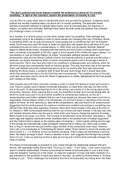“The play’s political and social aspects unsettle the audience but above all it is morally
unsettling.” In light of this comment, explore the presentation of morality in Loot.
Loot by Orton is a play which aims to intentionally shock and provoke the audience. It explores social,
political and morally unsettling ideas, but above all it is morally unsettling. The absurdist drama
satirises iconoclastic attitudes to highlight taboo topics, such as homosexuality, the hypocrisy of
religion, corruption and criminality. Although these topics are both social and political, they underpin
and challenge notions of morality.
As a member of a minority group in a time when society wasn’t as accepting, Orton perhaps was
purposefully trying to be unsettling in order to shock people into changing their way of thinking. Shock
is something which can be quite provoking for many people and is something that can’t be forgotten
easily. Orton may have used this factor to make his ideas stick with people and to get them to try and
understand his point of view on societal taboos. In 1959, Orton and his partner Kenneth Halliwell
began to deface library books, changing both their blurbs and front covers to things which would have
been considered unacceptable at the time, again to shock people of the middle and upper classes. In a
commentary of Loot by Andrew Mayne, he writes “ Iconoclastic attitudes towards death and
bereavement, piety and the Roman Catholic Church and towards authority in general and the police in
particular, are clearly intended by Orton to shock conventional opinion and to encourage a sense of
moral anarchy.” Orton may have also tried to be unsettling to challenge power and authority, which he
felt were corrupt and unnecessarily harsh on minority groups. This may have been due to the fact that
Orton and Halliwell were both arrested and sent to jail for six months after they were discovered
defacing the library books, a sentence both of them felt was much longer than it should have been,
which they believed was due to the fact that they were homosexuals. The unsettling nature of the play
could also have been used to show the theme of appearance vs reality, highlighting the fact that people
aren’t always as they seem.
Orton heavily uses both farce and black comedy in order to create this feeling of unrest and turmoil in
Loot. Farce is usually used to falsely incriminate characters, to make them look bad, but then at the
end of the work, it’s discovered that they’re not in the wrong, just unlucky or in the wrong place at the
wrong time. However, Orton subverts this in Loot, the characters turning out to be bad people after all,
which he could have used to try and further unsettle his contemporary audience, as this isn’t
reassuring them and further highlights that you can’t trust people just because they seem to be kind or
respectable. Andrew Mayne writes in his commentary of Loot that it shows a “reworking of the normal
pattern of Farce: far from returning us, after all the complications, safe and sound to an ordered world.”
Suggesting that the ending leaves the audience troubled and unsettled and perhaps is something very
different than what they were expecting. However, there were mixed reviews of the play at the time of
it’s release in 1965, some people believing that the use of farce and black comedy in the play was ‘sick’
and ‘twisted’ whereas others saw the way in which Orton was trying to change the opinions of society.
Martin Esslin in his essay ‘Joe Orton: The Comedy of (ill) Manners’ wrote that Orton “articulates […] the
same rage and helpless resentment which manifests itself in the wrecked train of football supporters”
and that “behind Orton’s attack on the existing state of humanity […] there stands nothing but the rage
of the socially and educationally under-privileged” implying that in writing Loot, Orton was no better
than a thug or vandal and was just another angry member of the uneducated lower class. However,
John Lahr in his introduction to ‘Entertaining Mr Sloane’ stated “Orton wanted to shock the society and
also to purify it. […] In showing us how we destroy ourselves, Orton’s plays are themselves a survival
tactic. He makes us laugh to learn. There is salvation in that.” Lahr suggests that through the comedic
factor of Loot, it aids our learning of what is right and wrong and it will be what eventually changes the
views of society.
The theme of homosexuality is prevalent in Loot, mainly through the relationship between Hal and
Dennis, Hal repeatedly calling Dennis baby, “Don’t go on, baby.”, “I can’t baby.”, a pet name commonly
used in romantic relationships. A theory surrounding the theme of homosexuality in Loot is that Orton
uses the metaphor ‘coming out of the closet’, to make the cupboard “a trope, that alerts members of a
gay subculture to the presence of same-sex desire in the play”, as written by Emma Parker in “A Close
reading of Loot.’. “Orton challenges the institutions that force homosexuality into hiding when Hal hides





